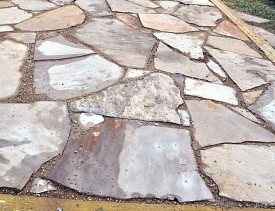A Flagstone Patio Replaces an Old Rotten Deck
 A Denver area carpentry client of mine was looking at a replacing an old deck. Years and years of weather and a slack maintenance plan had put this deck into a state of ugliness and decay. Its close proximity to an irrigated flowerbed provided the death sentence. It was time for some deck remodeling work.
A Denver area carpentry client of mine was looking at a replacing an old deck. Years and years of weather and a slack maintenance plan had put this deck into a state of ugliness and decay. Its close proximity to an irrigated flowerbed provided the death sentence. It was time for some deck remodeling work.
We opted to install a flagstone patio as a replacement. Flagstone is a good choice for those that want a lower maintenance option than a hardwood deck.
The First Steps
Before the flagstone project came to life, the decaying mess of the old deck had to be removed -- pretty straightforward work. We brought in a 3 yard dumpster and I dove in with my reciprocating saw. Cutting the old wood into manageable pieces was pretty easy. Dragging them around the house to the dumpster was a bit more work. That long path was further put to the test, as the bulk of the patio materials were also hand carried to the back yard.
Once we got rid of the rotten lumber, the old (undersized) deck footers were then removed. Here I was glad the previous builder had used such wimpy construction methods. Some of those footers were only a foot deep, well below the 3 feet required by code for proper frost depth.
The Containment Field
In a lot of patios the final grade is designed to match the surrounding yard. In this project the owner plans to do some additional landscaping work that will enhance the grass component of the back yard. Nearby tree roots and erosion left parts of the yard with an irregular soil profile. The future plan is to bring in fill to correct some of these leveling issues.
Normally one would dig out soil, then add a crushed stone base to create a flagstone patio. Here, though, I built a landscape timber frame that was then filled with the crushed stone. This served two purposes: contain the patio area and eliminate the need to haul away soil etc. The timbers were lap jointed and set with lengths of rebar to provide a strong and long lasting frame.
Crusher Fine Base
Crusher fines are a mix of fine gravel and sand-sized particles. This material makes an excellent substrate, as it is firm and strong when compacted, and far less prone to washing out than plain coarse sand. For the patio area of 200 sq. ft , about 2 ¼ yards were needed to level the space. This material was man hauled in, with the help of many 5-gallon buckets. It would have been nice to use a backhoe but the fence and gate configuration did not allow this type of access. Aside from the great exercise it provided, laying down the gravel in multiple tamped layers ensures a sound foundation.
The 4000-Pound Jigsaw Puzzle
Once the base was filled to a level a stone’s thickness below the timbers, the puzzle work began. This natural flagstone varied in thickness from 1” or so up to 2”. I set the field with the largest stones first, placing the corners and edges and working my way inward. The smaller ones were then fitted and the whole project fine-tuned with the littlest bits. Minor adjustment to the base material was done on an "as needed" basis, using a pry bar and small trowel. When the entire area was leveled and filled as well as possible, some additional crusher fines were added to lock everything in place. Rinsing the stones with the garden hose and sweeping helped lock it all together as well.
Kevin Stevens writes for networx.com.
Updated July 25, 2018.
Looking for a Pro? Call us (866) 441-6648

Landscaping Average Costs
Landscapers Experiences

We Finally Extended Our Concrete Patio And Our Yard Looks Amazing

Seamless Extension Of Concrete Patio And Poolside Retaining Wall



